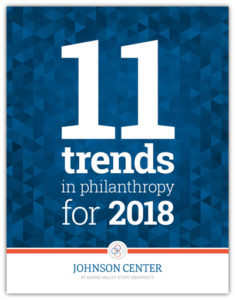Data to What End?


Download and read the full report, featuring all 11 trends for 2018, here.
 Despite talk of moving to a “post-fact” society, the push for data to inform decision-making in philanthropy continues to develop traction. This can be seen on all sides — data for nonprofits to increase their impact and better serve their communities, data for funders to make more strategic decisions about who to fund and how to address needs, and data for next-generation donors to inform their giving. Impact is the driving desire and data are the vehicle. At times, however, the push to collect data to inform decision-making can be so central that the goal of the data gets lost. Furthermore, nonprofits have long reported that the call for data without adequate funding and organizational capacity can be detrimental to their efforts (Snibbe, 2006).
Despite talk of moving to a “post-fact” society, the push for data to inform decision-making in philanthropy continues to develop traction. This can be seen on all sides — data for nonprofits to increase their impact and better serve their communities, data for funders to make more strategic decisions about who to fund and how to address needs, and data for next-generation donors to inform their giving. Impact is the driving desire and data are the vehicle. At times, however, the push to collect data to inform decision-making can be so central that the goal of the data gets lost. Furthermore, nonprofits have long reported that the call for data without adequate funding and organizational capacity can be detrimental to their efforts (Snibbe, 2006).
A key trend coming in philanthropy is to ask, “data to what end?” The effort to “right-size” our data inquiry has been a topic of more recent attention, including findings from Bopp, Harmon, and Voida (2017) that show the path to become data-driven can lead to erosion of autonomy, data drift, and data fragmentation in mission-driven organizations. Despite these concerns that the call for data may result in information overload and be unnecessarily taxing on organizations, research still indicates that measuring performance improves strategic decision-making (LeRoux & Wright, 2010).
“[T]he push for more data can at times result in collecting anything and everything without any intentional strategy.”
So what is the sector to do? Data help inform strategic decisions, but the quest for such information can also interfere with actual service delivery. Data that will not be used are not useful. This would seem to be common sense, but the push for more data can at times result in collecting anything and everything without any intentional strategy. Data should be used to answer key questions and inform decisions. Data should focus on both outputs (such as the number of grant dollars given or number of people served) and outcomes (the change made, such as increases in academic achievement, improvements in household income, etc.). If the data will not change the way a service/activity is delivered, then collecting them may not be the best use of resources.
A key element in ensuring that we can use the information we gather appears to be organizational capacity. Campbell and Lambright (2016) noted that many nonprofits indicate that their data efforts are funder-driven, even while funders often find that the data they receive from grantees do not provide them with all the information they would like and they often lack the capacity to use grantees’ performance data fully. This dilemma may be addressed by both “right-sizing” the data requested from nonprofits as well as increasing the data capacity of both nonprofits and funders. Increasing data capacity may include providing technical assistance to grantees to ensure they can collect the right information and manage it in the simplest ways possible.
It may also include work within foundations to ensure they are firm in their conceptualization of their theory of change and in articulating what data they really need in order to measure progress. In an age of high demand for information without endless resources to collect and consume that information, understanding how and why data will be used can be a first step to bringing rationality to the desire for data.

Bopp, C., Harmon, E., Voida, A. (2017). Disempowered by data: Nonprofits, social enterprises, and the consequences of data-driven work. Presented at the Computer-Human Interaction conference, Denver, CO. May 6–11, 2017.
Campbell, D. and Lambright, K. (2016, November 3). Struggling to get it right. Nonprofit Management & Leadership 27(3), 335–351.
LeRoux, K. and Wright, N. (2010). Does performance measurement improve strategic decision making? Findings from a national survey of nonprofit social service agencies. Nonprofit and Voluntary Sector Quarterly, 39(4), 571–587. Retrieved from https://doi.org/10.1177/0899764009359942.
Snibbe, A. (2006). Drowning in data. Stanford Social Innovation Review. Fall (2006). Retrieved from https://ssir.org/articles/entry/drowning_in_data.